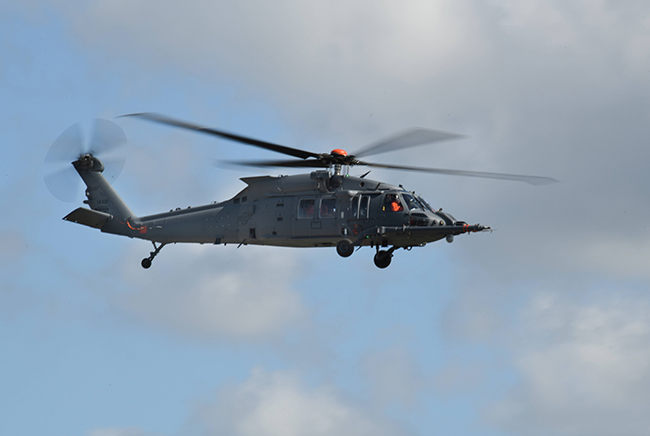
Sikorsky's HH-60W Combat Rescue Helicopter is shown during its first-ever flight on May 17, 2019, in Florida. Sikorsky courtesy photo.
Nearly 20 years after the Air Force first embarked on its search for a new combat search-and-rescue helicopter with the CSAR-X program, the helicopter that will replace the legacy HH-60G Pave Hawk flew for the first time May 17 in Florida.
Sikorsky’s HH-60W Combat Rescue Helicopter, based on the Army’s UH-60, is slated to replace an HH-60G fleet from the 1980s in a $7.1 billion procurement program that includes 112 combat, test, and training assets.
Over more than an hour, the initial flight test proved whether the Pave Hawk II could perform basic vertical-lift maneuvers: going forward, braking, left- and right-hand turns, hovering, speeding forward, back, left and right, automated pitch and roll moves, accelerating from 10 knots to 100 knots, turning at 80 knots, and more, said Greg Hames, Sikorsky’s CRH program manager.
“The first several weeks of the first flights would be what we would call ‘shaking down the systems’—your avionics systems, your dynamic control systems, your airframe systems, landing gear, etc., rotorblade systems,” Hames said in a May 13 interview. “Once you have identified those systems are all acting as designed, … you then move from those system shakedowns into what I’ll call performance.”
The helicopter’s maiden flight went smoothly, test pilot John Biscaino told Air Force Magazine May 17, and didn’t point to any needed changes.
“What I do think is going to happen is that pilots that have been flying the HH-60G, who are used to the older analog or what we call the ‘steam gauge’ type of displays, will in a very short matter of time get very accustomed to flying with primary flight displays,” Biscaino said. “All of that [flight data] is one-stop shopping. It’s right in front of you on the display for the pilots to monitor.”
He said he’s seen pilots acclimate to the digital cockpit in five to 10 hours.
Biscaino also pointed to improved situational awareness and missile warning systems, calling them game-changers for future search-and-rescue operations.
“That’s going to allow this aircraft to be a much bigger player and a much bigger asset in theater because essentially the eyes and ears of the aircraft are going to be much more expanded than what they currently are,” he said.
CRH boasts a 660-gallon fuel tank for greater range, a digital cockpit, and additional surveillance equipment, among other features that will be vetted individually. Sikorsky will later make sure the helicopters can go through the motions of rescuing someone in distress, watching its performance in real life rather than using simulations.
Dana Fiatarone, Sikorsky’s vice president for Army and Air Force programs, said some of the CRH mission equipment that Pentagon testers reported needed more work is going through qualification tests now, while others will be qualified as the summer progresses.
For example, testers are firing ammunition and clay shots at the helicopter’s ballistic armor to vet its resiliency, along with seeing how it holds up to vibration. An enhanced seat that is new to the Whiskey model is still finishing qualifications, and a rescue hoist with an electric engine is going through environmental testing. The gun mount’s vibration testing is also in progress.
All four qualifications are expected to finish within the next six months in concert with the Milestone C, or initial production, decision.
Another helicopter will make its first flight next week and two more later this summer, “flooding the hangar” to collect as much data as possible before the Air Force decides in September whether to start low-rate initial production, Fiatarone said.
“We will continue with about another 150 hours of aircraft flight testing, which would really begin to mature future avionics software drops,” Hames added.
He added the true test of the helicopter’s performance will come at military bases and ranges other than Sikorsky’s West Palm Beach, Fla., site.
Initial operational test and evaluation is slated to begin in the first half of fiscal 2021, said Ed Stanhouse, who runs the Air Force’s helicopter program office. Developmental test should end in September 2020, after which Sikorsky will deliver four aircraft to Moody AFB, Ga., and four aircraft to Kirtland AFB, N.M., for maintainer training and further testing.